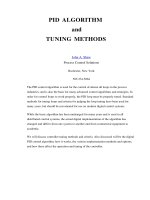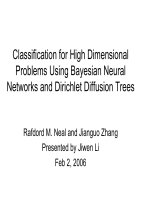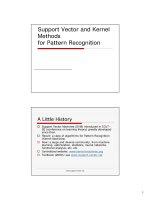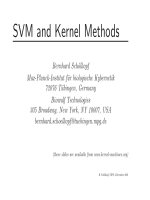PID ALGORITHM AND TUNNING METHODS
Bạn đang xem bản rút gọn của tài liệu. Xem và tải ngay bản đầy đủ của tài liệu tại đây (190.41 KB, 40 trang )
PID ALGORITHM
and
TUNING METHODS
John A. Shaw
Process Control Solutions
Rochester, New York
585-234-5864
The PID control algorithm is used for the control of almost all loops in the process
industries, and is also the basis for many advanced control algorithms and strategies. In
order for control loops to work properly, the PID loop must be properly tuned. Standard
methods for tuning loops and criteria for judging the loop tuning have been used for
many years, but should be reevaluated for use on modern digital control systems.
While the basic algorithm has been unchanged for many years and is used in all
distributed control systems, the actual digital implementation of the algorithm has
changed and differs from one system to another and from commercial equipment to
academia.
We will discuss controller tuning methods and criteria. Also discussed will be the digital
PID control algorithm, how it works, the various implementation methods and options,
and how these affect the operation and tuning of the controller.
Chapter 1
The Feedback Control Loop
The system measures the process, compares it to a setpoint, and then manipulates
the output in the direction which should move the process toward the setpoint.
Valve Linearity
Valves are usually non-linear. That is, the flow through the valve is not the same as
the valve position. Several types of valves exist:
Linear
Same gain regardless of valve position
Equal Percentage
Low gain when valve is nearly closed
High gain when valve is nearly open
Quick Opening
High gain when valve is nearly closed
Low gain when valve is nearly open
As we will see later, the gain of the process, including the valve, is very important to
the tuning of the loop.
• If the controller is tuned for one process gain, it may not work for other process
gains.
Valve Linearity:
Installed characteristics
The flow vs. percent open curve changes due to the head loss in the piping
At low flow, the head loss through the pipes is less , leaving a larger differential
pressure across the valve.
At high flow, the head loss through the pipe is more, leaving a smaller differential
pressure across the valve.
The effect is to increase the non-linearity of most valves.
Fail Open Valves
Valves are usually either: Fail Closed, air to open or
Fail Open, air to close
• Regardless of the way the valve operates, the operator is interested in
the knowing and adjusting the position of the valve, not the value of the
signal. "Up is always open"
• All controllers have some means of indicating the controller output in
terms of the valve position. When the operator increases the output as
indicated on the controller, the valve opens.
Indication Inversion
The output
indication is
inverted.
The controller
action takes the
valve action
into acount.
The flow loop
is direct
acting.
Most analog
controllers
work like this.
Signal Inversion
The output
signal is
inverted.
The controller
action ignores
the valve
action.
The flow loop
is reverse
acting
Some
distributed
control systems
work like this.
Chapter 2
The Process Response to the Controller
Steady state relationships:
Relating valve change to measurement
change
Steady state relationships:
changing load
When the load changes, either the process value changes or the valve position must be
changed to compensate for the load change.
Process Dynamics: Simple lag
Process Dynamics: Dead time
Dead Time: A delay in the loop due to the time it
takes material to flow from one point to another
Also called: Distance Velocity Lag
Transportation Lag
Most loop combine dead time and lag.
Measurement of dynamics
The dynamics differ from one loop to another.
However, they usually result in a response curve like this:
L is Lag—the largest lag in the process loop.
D is "Pseudo Deadtime"—the sum of the deadtime and all lags other than the largest
lag.
Disturbances
Almost all processes contain disturbances.
Disturbances can enter anywhere in the process.
The effect of the disturbance can depend on where it enters the loop.
Most disturbances cannot be measured.
Chapter 3
The PID algorithm
Action
PROCESS ACTION
Defines the relationship between changes in the valve and changes in
the measurement.
DIRECT Increase in valve position causes an increase in the
measurement.
REVERSE Increase in valve position causes a decrease in the
measurement.
CONTROLLER ACTION
Defines the relationship between changes in the measured variable
and changes in the controller output.
DIRECT Increase in measured variable causes an increase in the
output.
REVERSE Increase in measured variable causes a decrease in the
output.
The controller action must be the opposite of the process action.
Auto/Manual
Manual Mode:
The operator adjust the output to operate the plant.
During startup, this mode is normally used.
Automatic Mode:
The control algorithm manipulates the output to hold the process measurements at
their setpoints.
This should be the most common mode for normal operation.
Key concepts
The PID control algorithm does not "know" the correct output to bring
the process to the setpoint.
• It merely continues to move the output in the direction which should move the
process toward the setpoint.
• The algorithm must have feedback (process measurement) to perform.
The PID algorithm must be "tuned" for the particular process loop.
Without such tuning, it will not be able to function.
• To be able to tune a PID loop, each of the terms of the PID equation must be
understood.
• The tuning is based on the dynamics of the process response.
The PID Control Algorithm
The PID control algorithm comprises three elements:
• Proportional - also known as Gain
• Integral - also known as Automatic Reset or simply Reset
• Derivative - also known as Rate or Pre-Act (TM of Taylor Instrument Co.)
The algorithm is normally available in several combinations of these elements:
• Proportional only
• Proportional and Integral (most common)
• Proportional, Integral, and Derivative
• Proportional and Derivative
We will examine each of the three elements below:
Proportional
E = Measurement - Setpoint (direct action)
E = Setpoint - Measurement (reverse action)
Output = E * G + k
The output is equal to the error times the gain plus the manual reset.
If the manual reset stays constant, there is a fixed relationship between the setpoint,
the measurement, and the output.
Proportional—units
The proportional or gain term may be calibrated in two ways:
Gain and Proportional Band
Gain = Output/Input
Increasing the gain will cause the output to move more.
Proportional band is the % change in the input which would result in a 100%
change in the output.
Proportional Band = 100/Gain
We will use gain in this document.
Proportional—Output vs. Measurement
(Reverse acting)
Proportional only control produces an offset. Only the adjustment of the manual reset
removes the offset.
Proportional—Offset
Offset can be reduced by increasing gain.
Proportional control with low gain
Proportional control with higher gain
Proportional—Reducing offset with manual reset
Offset can be eliminated by changing manual reset.
Proportional control different manual reset
Adding automatic reset
With proportional only control, the operator "resets" the controller (to remove offset)
by adjusting the manual reset:
This manual reset may be replaced by automatic reset which continues to move the
output whenever there is any error:
This is called "Reset" or Integral Action .
Note the use of the positive feedback loop to perform integration.
Reset or integral mode
Reset Contribution:
Out = g X Kr X integral of error
where g is gain, Kr is the reset setting in repeats per minute.
Units used to set integral or reset
Assume a controller with proportional and integral only.
Calculation of repeat time: (gain and reset terms used in controller)
With the error set to zero (measurement input = setpoint), make a change in the input
and note the immediate change in output. The output will continue to change (it is
integrating the error). Note the time it takes the output to, due to the integral action,
repeat the initial change made by the gain action.
Some control vendors measure reset by repeat time in minutes. This is the time it
takes the reset (or integral) element to repeat the action of the proportional element.
Others measure reset by "repeats per minute".
• Repeats per minute is the inverse of minutes of repeat
This document will use repeats per minute.
Derivative
First used as a part of a temperature transmitter ("Speed-Act™" - Taylor Instrument
Companies) to overcome lag in transmitter measurement.
Also known as Pre-Act and Rate.
Derivative Contribution:
Out = g x Kd x de/dt
where g is gain, Kd is the derivative setting in minutes.
Response of controller with proportional and derivative:
The amount of time that the derivative action advances the output is known as the
"derivative time" measured in minutes.
All major vendors measure derivative (Derivative, Rate) the same.
Complete PID response
Non-Interactive (text book) form:









